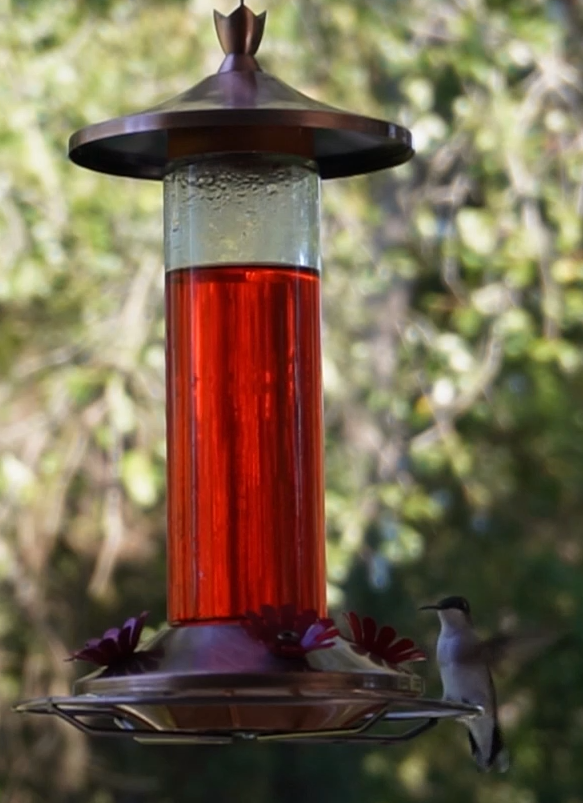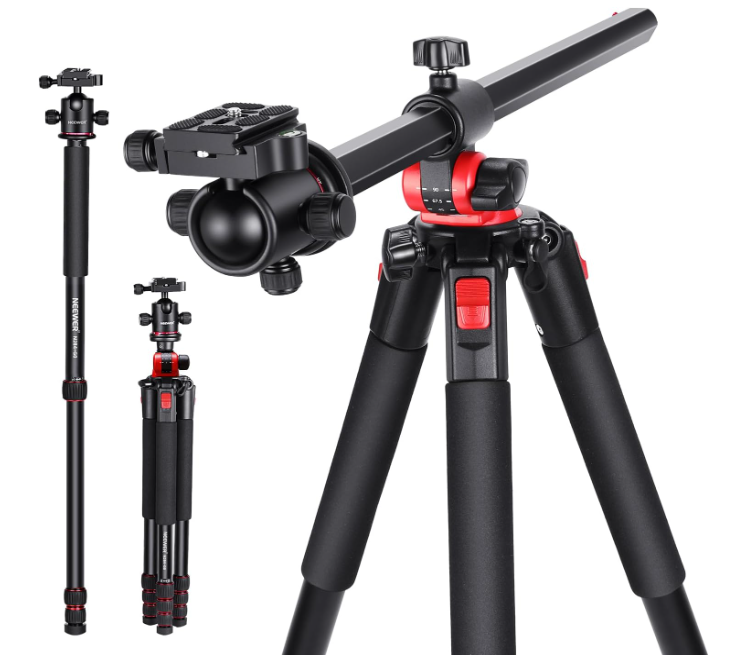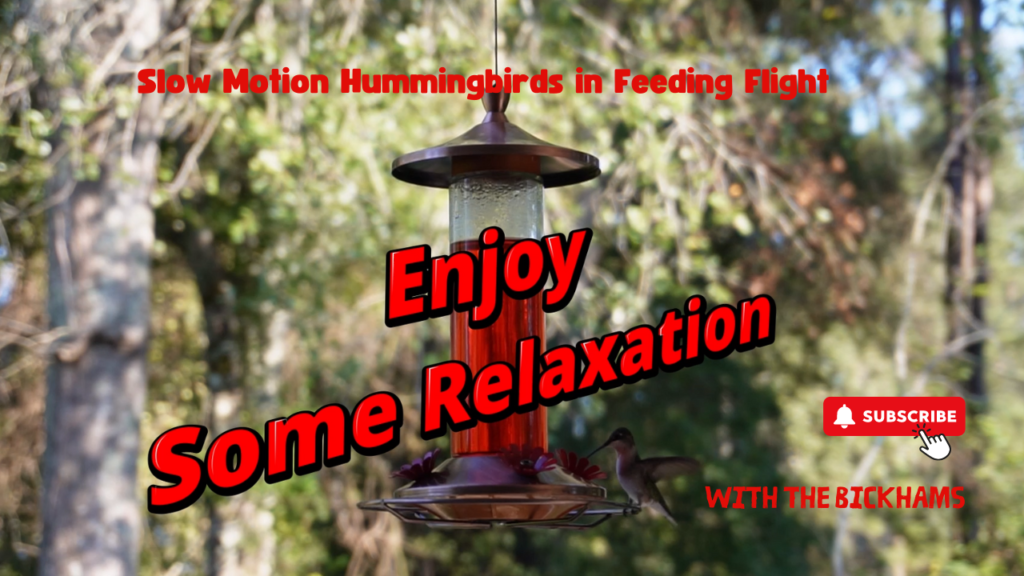The Joy of Hummingbirds: God’s Tiny Miracles That Relax the Mind and Soothe the Soul
There’s something mesmerizing about watching hummingbirds. Their tiny, iridescent bodies zipping around, wings flapping so fast they become a blur, all while they gracefully hover to sip nectar from feeders or flowers. At first glance, they may seem like just another beautiful creature in God’s magnificent creation, but if you spend just a few minutes watching them, you’ll quickly see there’s so much more to these little birds.
In our home here in Southwest Mississippi, Melissa and I are fortunate to host these tiny marvels. We’ve captured slow-motion footage of them feeding, paired it with some relaxing music, and created a peaceful video experience. It’s the perfect way to kick back, clear your mind, and reflect on the wonder of nature. I invite you to explore why these hummingbirds can bring you peace, relaxation, and a reminder of God’s incredible handiwork.

Why Hummingbirds Can Help You Relax
Let’s face it—life can get overwhelming. The pressures of work, family, and day-to-day responsibilities often leave little time to unwind. That’s where the simple act of watching hummingbirds can come in. Just like other forms of nature therapy, bird-watching can help calm the mind and reduce stress.
Hummingbirds, in particular, offer a unique experience because they’re fast, agile, and always moving, yet at the same time, they have a calming effect. Their gentle buzzing, the flash of colors, and their rhythmic movement as they feed can make you feel as though time has slowed down. It’s almost like a living form of art—one that you don’t just observe but feel in your soul.
This sense of tranquility can do wonders for your mental and physical health. Studies have shown that spending time in nature can lower cortisol levels (the stress hormone), reduce anxiety, and improve overall well-being. Watching hummingbirds can provide a meditative moment—where the beauty and intricacy of their flight takes you away from the hustle and bustle of daily life, even if just for a little while.
What Hummingbirds Stand For
Hummingbirds are not just pretty to look at; they also carry deep symbolic meaning in many cultures. One of the most prominent beliefs is that the hummingbird represents joy, resilience, and hope. Despite their small size, these birds are incredibly strong and persistent, much like the human spirit. When you watch a hummingbird, you can be reminded of the power of positivity and perseverance, no matter the challenges life throws your way.
For many, the hummingbird also symbolizes healing. Their ability to move so effortlessly from flower to flower is often seen as a metaphor for healing wounds—both physical and emotional. They remind us to find joy even in the smallest moments and that, just like these little creatures, we can rise above the hardships we face and continue to move forward.
From a spiritual perspective, hummingbirds are often viewed as messengers from Heaven. Some believe that when a hummingbird visits, it’s a loved one who has passed, letting you know they are close by, watching over you. Others see hummingbirds as a symbol of God’s miracles—a reminder that the beauty of creation is always around us if we just take the time to notice it.
The Miracle of God’s Creation
Hummingbirds aren’t just fascinating because of their speed or size; they’re one of God’s many miracles in this world. It’s easy to see His touch in the intricacies of their creation. Each hummingbird is a masterpiece of design. Their ability to fly forward, backward, and even hover mid-air is a feat of engineering that human minds have yet to replicate fully.
Their wings flap anywhere from 50 to 80 times per second, a rate so fast that it creates a faint humming sound—hence their name. They can even dive at speeds of up to 60 miles per hour when threatened or during courtship rituals. For a bird that typically weighs no more than a nickel, that’s astonishing!
What’s even more incredible is their migration. Some species, like the Ruby-throated Hummingbird, make a journey of up to 3,000 miles between their breeding and wintering grounds, flying across the Gulf of Mexico without stopping. Can you imagine flying non-stop for 500 miles straight? That’s not just biology—that’s miraculous!
When I watch these little birds flutter around our feeders, I see more than just an animal. I see a reflection of God’s creativity, His attention to detail, and His love for beauty. The way they’re designed to thrive and adapt, despite their small size, is a reminder that no matter how insignificant we may feel at times, God’s love and care extend to all His creation—no detail is too small for Him.
Our Backyard Visitors: A Hummingbird Haven
Here at With the Bickhams, we’ve created our own little hummingbird haven. We love sitting on the porch, watching them zip around our feeders. It’s an activity that has become a favorite in our family, and we’re always excited when the first ones show up in the spring. We’re not the only ones who find joy in these tiny birds—hummingbird feeders are a common sight in many backyards across America, especially in the South, where these birds are frequent visitors.
To attract hummingbirds, we keep our feeders filled with fresh nectar. It’s important to note that hummingbirds don’t need red dye in their food. In fact, the dye can be harmful to them. If you do choose to add color, just a drop or two of red food coloring is all that’s needed, but you don’t have to add it. The hummingbirds will still come to your feeder without the red color, as long as the feeder has some bright red accents that naturally attract them.
We make our own nectar using a simple 4:1 water to sugar ratio, which mimics the natural nectar they would find in flowers. It’s easy to make, and the birds love it!
What’s fascinating is how territorial they are. Despite their small size, hummingbirds can be quite feisty when it comes to protecting their food sources. It’s not uncommon to see one bird chase away another as they compete for space at the feeder. It’s a tiny drama that plays out daily in our backyard, and it’s one that never gets old.
Capturing Their Beauty: The Art of Slow Motion
One day, as we were enjoying our hummingbirds, I had the idea to capture them on video. But I didn’t want just any ordinary video—I wanted to show the elegance and grace of their movements in a way that could truly be appreciated. So I set up my Sony ZV-E10 camera and recorded them in slow motion as they fed at our feeders. ( I used my Neewer 72-inch Camera Tripod Monopod)
The result? A beautiful, mesmerizing video that highlights every tiny detail of their flight. In slow motion, you can see how their wings beat the air, how they hover so effortlessly, and how they dart from flower to flower with perfect precision. It’s as if you’re watching them in a whole new light.
To make the experience even more relaxing, I added some soothing music to the video. It’s the perfect combination of nature and sound—a little escape from the world where you can sit back, put the video on the TV, and let your mind and body relax.
The Equipment Behind the Scenes
If you’re curious about how I captured our hummingbirds in slow motion and set it all to relaxing music, I used the Sony ZV-E10 camera. This camera is perfect for capturing the fast-paced, intricate movements of hummingbirds in stunning detail, allowing us to slow down their flight and truly appreciate their beauty. Along with the Sony ZV-E10, I used a sturdy tripod to keep the shots stable and professional, and video editing software to combine the footage with soothing music.
All of the equipment I used, including the Sony ZV-E10, can be found on our With the Bickhams Amazon Storefront. Whether you’re a nature enthusiast wanting to capture your own backyard wonders, or someone looking to create calming, high-quality videos, this gear will help you get started. Take a look at the tools we trust, and you’ll be creating your own peaceful, nature-inspired videos in no time!


How to Create Your Own Hummingbird Oasis
If you’ve ever wanted to attract hummingbirds to your yard, it’s easier than you might think. Here are a few tips to help you get started:
- Set Up Feeders: The simplest way to attract hummingbirds is by setting up feeders. Look for feeders with bright red accents (hummingbirds are attracted to red), and keep them filled with a homemade nectar solution (4 parts water to 1 part sugar). Clean your feeders regularly to prevent mold growth.
- Plant Hummingbird-Friendly Flowers: Hummingbirds love flowers with tubular shapes because they can easily reach the nectar with their long beaks. Some great plants to consider include bee balm, salvia, trumpet vine, and fuchsia.
- Provide Water: Hummingbirds love shallow water sources, especially those that have misters or fountains. They enjoy flying through the mist to cool down and clean their feathers.
- Give Them Space: Hummingbirds can be territorial, so providing multiple feeders spaced apart will help reduce competition. It will also encourage more birds to visit your yard.
- Be Patient: It may take a little time for hummingbirds to discover your feeders, but once they do, they’ll likely return year after year.
Relax, Reflect, and Be Inspired
As you watch our video and maybe even try attracting hummingbirds to your own backyard, I hope you take a moment to reflect on these tiny miracles. They may be small, but they have a huge impact, both in nature and in our hearts.
Hummingbirds are a reminder of the beauty and complexity of life—how even the smallest of creatures can inspire awe and wonder. They show us that God’s hand is in everything, from the grandest mountains to the tiniest birds. And in a world that’s often chaotic and stressful, hummingbirds offer a peaceful escape—a chance to relax, breathe, and appreciate the miracle of creation.
Watch Our Hummingbird Slow Motion Video Above
Affiliate Disclaimer and Legal Disclaimer
Affiliate Disclaimer: There are affiliate links on this page. If you click a link and make a purchase, I may receive compensation at no additional cost to you.
Legal Disclaimer: I cannot guarantee any results. All the people on this page who use this product may have results that vary. No guarantees of wealth, fame, or success. But hey, at least you tried.

